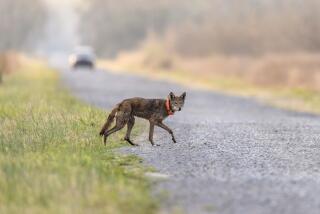Rare Gorillas Threatened by Rwanda Civil War : Africa: Naturalist Dian Fossey spent 18 years protecting the animals from poachers. The insurgency provides a new peril. Only 600 of the species remain in world.
- Share via
KIGALI, Rwanda — Amid the misty volcanoes of Rwanda, naturalist Dian Fossey spent 18 years studying rare mountain gorillas and protecting them from poachers.
Now researchers are in a battle to save the gorillas, this time from war.
Rebels launched a new offensive in Rwanda’s 2 1/2-year-old insurgency recently, prompting researchers and staff to flee Volcanoes National Park, where Fossey collected data for her book “Gorillas in the Mist,” later made into a movie.
Rebels deny that they were in the park when the fighting began on Feb. 8. But witnesses said men in the kind of uniforms often worn by the rebel Rwandan Patriotic Front besieged the area in the far northwest corner of the country, home to half of the 600 mountain gorillas in the world.
Buildings were ransacked and research was halted. Worse, the gorillas were left without the protection of anti-poaching squads for the first time since Fossey’s arrival in 1967. The rebels say government forces and people from a nearby town did the looting.
While the combatants try to implement a cease-fire, groups who fund projects at the park want it declared a permanent safe zone for the endangered gorillas.
“Even if this conflict blows over quickly, you could have a replay of this a couple of months down the road or a couple of years down the road,” said Dieter Steklis, an anthropology professor at Rutgers University in New Jersey and director of the research center.
Steklis and representatives of his funding organization, The Dian Fossey Gorilla Fund, recently visited the Rwandan Embassy and the rebel’s office in Washington to seek assurances that the park would remain peaceful.
“Finger pointing won’t do any good, but we like to make sure they understand what we are trying to do there,” he said.
“We are trying to steer a neutral course,” the fund’s president, Patricia McGrath, said from Englewood, Colo. “We are not political; we are there to protect the gorillas.”
McGrath’s group funds the Karisoke Research Center, named for Mt. Karisimbi and Mt. Visoke, two of several volcanoes that form the Virunga range in central Africa.
It was from her base at Karisoke that Fossey studied gorilla behavior and protected them from poachers who would sell them to zoos, or butcher them and sell their hands as ashtrays or trinkets.
Originally a physical therapist from California, Fossey discovered the gorillas to be gentle giants.
Her camp includes about a dozen wood and sheet-metal buildings, a cemetery for gorillas that died naturally or were killed by poachers, and the grave of Fossey, who was slain in 1985 at the age of 53. Her killing remains unsolved.
The rebels are mostly members of Rwanda’s minority Tutsi tribe, which ruled the country and subjugated the majority Hutus until they were overthrown in 1959. Many Tutsi fled to neighboring countries in the 1960s, but they invaded from Uganda in 1990.
A cease-fire was worked out last summer. But the new fighting has killed at least hundreds of people and displaced an estimated 1 million.
Under another cease-fire reached last month, the rebels were said to be pulling back from some areas. But it’s unknown when tourists and researchers will be able to return.
Thousands of people used to visit Rwanda’s parks every year. In the volcanoes park, tourists can view the gorillas with the help of trackers.
A couple of trackers recently sneaked to the edge of the park to check on the gorillas. They have been able to glimpse more than 30 and believe earlier fears of gorilla killings may have been unfounded, Steklis said.
About a week after the rebel offensive, a tracker of 20 years reported that he saw a blood-covered swath of flattened vegetation in the forest. Researchers suspected that rebels, Rwandan soldiers or poachers had shot at fleeing gorillas.
“Now they believe it may have been that one of the gorillas had a new baby,” McGrath said.
Conservationists are anxious to find out how all of the 300 guerrillas in the park are faring. Of the world’s 600 mountain gorillas, 300 live in Uganda, and the 300 in Rwanda often move back and forth over the border between Rwanda and Zaire.
Steklis said the threat gorillas faced during Fossey’s time has been renewed.
“But in a way it’s worse now, because the center is abandoned--no one is able to do anti-poaching patrols, to have contact with the gorilla groups to make sure they are OK.”
More to Read
Sign up for Essential California
The most important California stories and recommendations in your inbox every morning.
You may occasionally receive promotional content from the Los Angeles Times.












